David1226
Registered
Some time ago I created a number of open goods wagons for the Claptowte Railway but until now these ran empty as I had not modelled any freight to be transported on these wagons. I will quote an extract from the written history of the Claptowte Railway, which inspired me to create some large packing crates.
“Since the dawn of the Industrial Revolution, a number of small independent engineering machine shops, dotted about the Vale, have specialised in, and become renowned for, the manufacture of watnaims, in fact, Claptowte watnaims are known to Mechanical Engineers all over the world. There cannot be many engineering installations around the former British Empire not fitted with a Claptowte watnaim.“
I was recently in one of those emporiums that sell anything and everything for not a lot of money. On a shelf I found a number of small, variously shaped, unfinished plywood boxes, presumably intended to be used as trinket boxes. There was a rectangular box 100 x 60 x 40 mm which I thought, with a bit of framing, would make an ideal large crate for the transport of Claptowte watnaims. They were only £1.49 each.
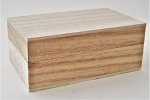
The framing material was obvious as I already had a quantity of wooden coffee stirrers. Thus the following adaption was executed.
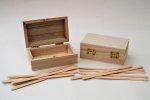
The first job was to remove the hinges. The pointed end of a wooden cocktail stick, dipped in a drop of white PVA glue, was pushed into the screw holes. When set, the cocktail sticks were cut and sanded flush with the surface. When this was done, the two halves of the box were clued together with PVA glue and when that was set, all joins were sanded smooth and flush. The outside framing of the crate was then added by sticking on lengths of wooden coffee stirrer, using, you’ve guessed it, white PVA glue.. Once the glue was set, the edges and ends were tidied up with a bit more sanding. As the crate was created using new, unfinished plywood and timber, there is no painting to be done, the finish being natural.
I had some ¼” square strip wood in my odds & ends box for more years than I care to remember, I cut three lengths of this to glue on the underside of the crate to raise it off ground level.
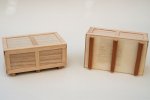
All that remained to do was to paste on some relevant signage created with the computer printer.
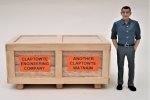
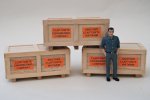
I decided that one of the low sided open goods wagon could carry two of these crates, the third crate would be placed next to the yard crane at Gernise End Station, ready for hoisting.
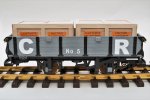
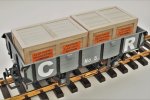
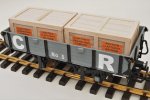
David
“Since the dawn of the Industrial Revolution, a number of small independent engineering machine shops, dotted about the Vale, have specialised in, and become renowned for, the manufacture of watnaims, in fact, Claptowte watnaims are known to Mechanical Engineers all over the world. There cannot be many engineering installations around the former British Empire not fitted with a Claptowte watnaim.“
I was recently in one of those emporiums that sell anything and everything for not a lot of money. On a shelf I found a number of small, variously shaped, unfinished plywood boxes, presumably intended to be used as trinket boxes. There was a rectangular box 100 x 60 x 40 mm which I thought, with a bit of framing, would make an ideal large crate for the transport of Claptowte watnaims. They were only £1.49 each.

The framing material was obvious as I already had a quantity of wooden coffee stirrers. Thus the following adaption was executed.

The first job was to remove the hinges. The pointed end of a wooden cocktail stick, dipped in a drop of white PVA glue, was pushed into the screw holes. When set, the cocktail sticks were cut and sanded flush with the surface. When this was done, the two halves of the box were clued together with PVA glue and when that was set, all joins were sanded smooth and flush. The outside framing of the crate was then added by sticking on lengths of wooden coffee stirrer, using, you’ve guessed it, white PVA glue.. Once the glue was set, the edges and ends were tidied up with a bit more sanding. As the crate was created using new, unfinished plywood and timber, there is no painting to be done, the finish being natural.
I had some ¼” square strip wood in my odds & ends box for more years than I care to remember, I cut three lengths of this to glue on the underside of the crate to raise it off ground level.

All that remained to do was to paste on some relevant signage created with the computer printer.


I decided that one of the low sided open goods wagon could carry two of these crates, the third crate would be placed next to the yard crane at Gernise End Station, ready for hoisting.



David
